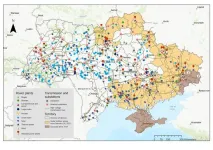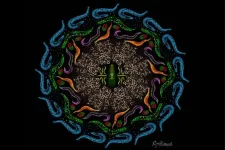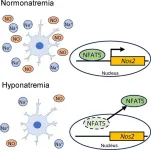(Press-News.org) One of the main targets of Russia’s ongoing attacks on Ukraine is the energy infrastructure. The extent of the destruction is enormous. “One year after the start of the war in February 2022, 76 percent of thermal power plants had been destroyed; now the figure is 95 percent,” says Ukrainian scientist Iryna Doronina. “And all the large hydroelectric power plants have also failed.” The breaching of the Kakhovka dam proved to be particularly devastating. The huge outflow of water – the reservoir covered an area 1.5 times bigger than the canton of Zurich – destroyed thousands of homes and left the reservoir a desert.
Before the war, Doronina was a lecturer at the Kyiv National University of Trade and Economics; in 2022, she came to ETH Zurich as an SNSF Scholar at Risk. This Swiss National Science Foundation programme provides Swiss universities with financial support so they can give temporary employment to researchers at risk. That’s how Doronina ended up as a Senior Researcher at the ETH Institute of Science, Technology and Policy (ISPT) until 2024. Today, she continues her research at the Technical University of Munich (TUM). In Zurich, she worked closely with the groups led by Adrienne Grêt-Regamey, Professor of Planning Landscape and Urban Systems (PLUS), and by Tobias Schmidt, Professor of Energy and Technology Policy and Head of the ISTP.
Together they looked into why renewables should take centre stage in the reconstruction of the Ukrainian electricity system. The corresponding findings, to which researchers from the Technical University of Munich and the University of Bayreuth also made valuable contributions, have now been published in Joule, a leading journal for energy research. “We’ve established that practically all Ukraine’s large, centralised power plants have been attacked since February 2022. This has reduced the total electricity generation capacity to around one-third of the pre-war level,” Schmidt says. “The grid has also been considerably weakened by attacks on transmission lines and substations, particularly in the east of the country.”
Capacity reserves are key to survival
In their study, the researchers combined geospatial and public policy analyses. “Our study presents the first comprehensive, geospatial mapping of Ukraine’s electricity system as it was in February 2022 and its subsequent destruction in the war,” Grêt-Regamey says. “We also show Ukraine’s renewables potential, and we identify the policy and regulatory conditions needed to facilitate investment.”
First, the researchers created a detailed map of Ukraine’s energy infrastructure before 2022. “We wanted to understand the scope of installed power generation capacity, so we mapped 1,626 sites,” Doronina says. “This information on plants and their locations, output, production and consumption serves as the basis for further analysis.” With 59 gigawatts of installed capacity, Ukraine was one of Europe’s biggest electricity producers before 2022. The country itself required 22 gigawatts. “That means Ukraine had considerable capacity reserves, which have helped it to survive during the war,” Doronina states.
Nuclear power plays a significant role. The Zaporizhzhia plant in southwest Ukraine, Europe’s largest nuclear power plant, was occupied by Russian troops and hasn’t supplied electricity since September 2022. However, a further three nuclear power plants with seven reactors between them remain operational in the east and south and continue to supply Ukraine with electricity. However, Russia’s repeated attacks on the distribution grid lead to hours-long power cuts, including in the capital city of Kyiv. “That’s why Ukraine should develop a distributed power supply system,” Doronina says. A centralised system is easier to attack, whereas independent systems are more resistant to war and crisis.
Moving to a decentralised energy system
Renewable power plants that harness solar or wind energy are particularly suitable for distributed infrastructure and can be installed much more quickly than centralized conventional plants. “However, municipalities must be able to produce enough renewable energy locally to meet their power needs,” Doronina says.
The researchers created high-resolution maps of Ukraine’s various regions, showing the areas in which power generation from solar and wind energy is most favourable. The team took into account several criteria such as altitude and topography, population density as well as distance to settlements and to power grids. “We meticulously considered protected areas and state agricultural land, ensuring full compliance with the requirements and limitations of Ukrainian legislation,” Doronina says.
Huge potential for solar and wind energy
Next, the researchers estimated energy output by region. This technical potential is enormous. The researchers estimate that the potential for wind energy is around 180 gigawatts, while for solar energy it’s around 39 gigawatts. A total capacity of 219 gigawatts would vastly exceed the generation capacity of 59 gigawatts that Ukraine had at the start of the war. Finally, the researchers found that in all the regional power grids, the potential for renewables far surpasses the power generation capacity destroyed during the war.
The researchers use the technical potential at regional level together with socio-political, economic, environmental and technological factors to determine which regions are most suitable for Ukraine’s transition to renewable energy systems. From a regional perspective, the greatest potential for solar and wind energy lies in the south and east of the country.
Supporting a well-governed new energy system
Until now, Ukraine’s energy infrastructure has been monopolised by one or two oligarchs. “They had control over the national energy market and worked together with Russia. It was also a breeding ground for corruption,” explains Vasyl Doronin, head of the NGO Ukrainian Hydrogen Association and coauthor of the study.
“The transparency of our results reduces the risk of corruption, as the proposed approaches to prioritise the areas with greater potential and those that urgently need to be redeveloped are scientifically sound and balanced,” Doronina says. “The maps and databases we developed support policymaking and are the fastest way to meet people’s basic energy needs.” In addition, this work improves the quality of project preparation and reduces risk for investors once the investment requirements have been clarified. “This study, a trailblazer in its field, was among the first to consider the requirements of the Renewable Energy Directive III of the EU (RED III), identifying renewable accelerating areas,” Vasyl Doronin says. The results were presented to the European Commission at its Joint Research Center in the Netherlands.
“We want to go back to live in Ukraine again, and we hope our results will help in the country’s further development,” Doronina says. She wants her research to serve as the basis for a manual that will enable Ukrainian communities to switch their energy supply. Her aim is to create an “atlas of the potential for transforming the energy sector”.
Information for the Swiss authorities
What Ukraine is going through might also offer valuable insights for Swiss civil protection. For example, Doronina provided the Federal Office for Civil Protection (FOCP) with detailed information not only on Ukraine’s energy infrastructure and its destruction, but also on war damage to the agricultural and education sectors, including schools and kindergartens. “We showed how the war has affected civilian infrastructure in Ukraine, so that the Swiss can see what it actually looks like there and what might happen elsewhere,” Doronina says.
Furthermore, Doronina and her colleagues also presented their research at the event “Re-Thinking Energy Infrastructure: Empowering Decarbonisation – Moving from Strategy to Implementation” which ETH Zurich co-organised last January in the House of Switzerland at the WEF in Davos.
END
How Ukraine can rebuild its energy system
2024-09-18
ELSE PRESS RELEASES FROM THIS DATE:
Research points a way to modulate scarring in spinal cord injury
2024-09-18
Media Contact: laura.kurtzman@ucsf.edu, (415) 502-6397
Subscribe to UCSF News
After a spinal cord injury, nearby cells quickly rush to action, forming protective scar tissue around the damaged area to stabilize and protect it. But over time, too much scarring can prevent nerves from regenerating, impeding the healing process and leading to permanent nerve damage, loss of sensation or paralysis.
Now, UC San Francisco researchers have discovered how a rarely studied cell type controls the formation of scar tissue in spinal cord injuries. Activating ...
Breast and ovarian cancer newly linked to thousands of gene variants
2024-09-18
Scientists have pinpointed thousands of genetic changes in a gene that may increase a person’s risk of developing breast and ovarian cancer, paving the way for better risk assessment and more personalised care.
Researchers from the Wellcome Sanger Institute and their collaborators focused on the ‘cancer protection’ gene RAD51C, finding over 3,000 harmful genetic changes that could potentially disrupt its function and increase ovarian cancer risk six-fold and risk of aggressive subtypes of breast ...
Metal exposure can increase cardiovascular disease risk
2024-09-18
Metal exposure from environmental pollution is associated with increased calcium buildup in the coronary arteries at a level comparable to traditional risk factors like smoking and diabetes, according to a study published today in JACC, the flagship journal of the American College of Cardiology. The findings support that metals in the body are associated with the progression of plaque buildup in the arteries and potentially provide a new strategy for managing and preventing atherosclerosis.
"Our findings highlight the importance ...
Penny for your thoughts? Master copper regulator discovery may offer Alzheimer’s clues
2024-09-18
New therapeutic opportunities often emerge from research on simple organisms. For instance, the 2020 Nobel Prize in Chemistry awarded to Emmanuelle Charpentier, Ph.D., and Jennifer Doudna, Ph.D., for their CRISPR-based DNA editing discovery began with studies using bacteria just a decade prior. Today, CRISPR therapies are approved for several disorders, and more such treatments are in the offing.
Recognizing the translational potential of studies in simpler animal models, a team of scientists led by Randy D. Blakely, ...
Keck Hospital of USC named a 2024 top performer by Vizient, Inc.
2024-09-18
LOS ANGELES — Keck Hospital of USC has been named a top performer in the 2024 Bernard A. Birnbaum, MD, Quality Leadership award by Vizient, Inc., a leading health care performance improvement company.
The top performer designation acknowledges the hospital’s excellence in delivering high-quality care as measured by the annual Vizient Quality and Accountability Study.
Keck Hospital was among 14 top performers out of 115 comprehensive academic medical centers nationally and achieved a five-star ...
NSF and Simons Foundation launch 2 AI Institutes to help astronomers understand the cosmos
2024-09-18
Note: Embargoed until 8:00 a.m. ET on Sept. 18, 2024
From the early telescopes made hundreds of years ago by Galileo to the sophisticated astronomical observatories of today, people have built increasingly innovative tools to probe and measure the cosmos. Soon, researchers at two new institutes funded by the U.S. National Science Foundation and the Simons Foundation will build a new breed of astronomical tools by harnessing the uniquely powerful abilities of artificial intelligence to assist and accelerate humanity's understanding of the universe.
The new National Artificial Intelligence ...
Exploring the effect of low sodium concentrations on brain microglial cells
2024-09-18
Low serum sodium concentrations in blood are called hyponatremia, a prevalent clinical electrolyte disorder. In contrast to acute hyponatremia, chronic hyponatremia has been previously considered asymptomatic because the brain can successfully adapt to hyponatremia. If not treated, chronic hyponatremia can lead to complications such as fractures, falls, memory impairment, and other mental issues. Treating the chronic condition is, however, quite tricky as it has been observed that overly rapid correction of hyponatremia ...
New Alzheimer’s studies reveal disease biology, risk for progression, and the potential for a novel blood test
2024-09-18
EMBARGOED by Alzheimer’s & Dementia until 7 a.m., ET, Sept. 18, 2024
Contact: Gina DiGravio, Boston University, 617-358-7838, ginad@bu.edu
Contact: Andrea Zeek, IU School of Medicine, 317-671-3114, anzeek@iu.edu
(Boston)— The failure to diagnose Alzheimer’s disease, the most common form of dementia in the elderly, at an early stage of molecular pathology is considered a major reason why treatments fail in clinical trials. Previous research to molecularly diagnose Alzheimer’s disease yielded "A/T/N" central biomarkers based on the measurements of proteins, β-amyloid (“A”) and tau (“T”), ...
Comorbidity and disease activity in multiple sclerosis
2024-09-18
About The Study: In this study, a higher burden of comorbidity was associated with worse clinical outcomes in people with multiple sclerosis (MS), although comorbidity could potentially be a partial mediator of other negative prognostic factors. The findings suggest a substantial adverse association of the comorbidities investigated with MS disease activity and that prevention and management of comorbidities should be a pressing concern in clinical practice.
Corresponding Author: To contact the corresponding author, Amber Salter, PhD, email amber.salter@utsouthwestern.edu.
To access the embargoed study: Visit our For The Media website at this ...
£18 million for DARE UK to support secure research on sensitive data
2024-09-18
London, United Kingdom, 18 September 2024 – UK Research and Innovation (UKRI), the UK’s largest public funder of research, has confirmed funding for a new phase of the DARE UK (Data and Analytics Research Environments UK) programme with up to £18.2 million made available over 2.5 years.
Starting this month, Phase 2 of the DARE UK programme will bring together Trusted Research Environments (TREs) across the UK to test and build new capabilities for a connected national network of secure data ...




